
Extreme Weather, Health, and Communities
Springer International Publishing (Verlag)
978-3-319-30624-7 (ISBN)
Dr. Sheila Lakshmi Steinberg is a Professor of Social and Environmental Sciences at Brandman University-Chapman University System, Irvine, CA. The theme throughout her research is examining people and their relationship to space and place. Steinberg’s research interests include environmental sociology, research methods, social inequality, community, geospatial research (GIS) and policy. Sheila has always been interested in the weather and climate from living in so many different parts of the U.S. Recently, she co-authored a book entitled GIS Research Methods: Incorporating Spatial Perspectives for Esri Press and has also co-authored a chapter on this topic entitled "Geospatial Analysis Technology and Social Science Research" in the Handbook of Emergent Technologies, Sharlene Hesse-Biber, Editor, Oxford University Press 2011. In 2006, she co-authored a book for Sage Publications entitled, GIS for the Social Sciences: Investigating Space and Place. In 2013, she joined Brandman University where she now teaches courses related to social and environmental sciences.William A. Sprigg, Ph.D., Yale University is Research Professor Emeritus, University of Arizona, the current and founding director of the World Meteorological Organization’s Pan-America Center for airborne dust forecasting in Barbados, and research associate of the Public Health Institute in California. He is a member of the American Meteorological Society’s Board on Environment & Health, the Chinese Academy of Sciences Committee for Digital Earth Observations, and the Serbian Program of Basic Research, Environmental Protection and Climate Change. Former positions include Distinguished Professor at California’s Chapman University, Director, U.S. National Research Council Board on Atmospheric Science and Climate, head of the U.S. National Climate Program Office, and architect of the U.S. Climate Program. He participated in the first Intergovernmental Panel on Climate Change. Authoring a number of technical publications on climate and, most recently, on his current research interests, airborne dust and human health, Dr. Sprigg continues his interests in interdisciplinary research and science policy.
Introduction.- Superstorm Sandy: a Game Changer?.- Extreme Weather: Politicsand Public Communication.- Dust Storms, Human Health and a Global Early WarningSystem.- Interdisciplinary Engagement of People and Place around Extreme Weather.- Engaging Communitiesto Assess the Health Effects of Extreme Weather in the Arctic.- Refining theProcess of Science Support for Communities around Extreme Weather Events andClimate Impacts.- Reducing Vulnerability to Extreme Heat throughInterdisciplinary Research and Stakeholder Engagement.- Sociospatial Modelingfor climate-based emergencies: Extreme Heat Vulnerability.- Drought and Health in the Context of Public Engagement.-Extreme Weather:Mental Health Challenges and Community Response Strategies.- ExtremeWinter: Weaving Weather and Climate into a Narrative through Laura IngallsWilder.- The Air We Breathe: How Extreme Weather Conditions Harm Us.- HumanResponse to and Consequences of the May 22, 2011, Joplin Tornado.- Approachesfor Building Community Resilienceto Extreme Heat.
| Erscheinungsdatum | 08.10.2016 |
|---|---|
| Reihe/Serie | Extreme Weather and Society |
| Zusatzinfo | XXI, 388 p. 42 illus., 39 illus. in color. |
| Verlagsort | Cham |
| Sprache | englisch |
| Maße | 155 x 235 mm |
| Themenwelt | Naturwissenschaften ► Biologie ► Ökologie / Naturschutz |
| Naturwissenschaften ► Geowissenschaften ► Geologie | |
| Schlagworte | climate change adaptation • Climate Change/Climate Change Impacts • Climate change impacts • community engagement • Drought • dust storm • Earth and Environmental Science • Earth System Sciences • emergency services • Environmental Change and Health • extreme heat • Extreme weather • Gemeinschaft • Gesellschaft • Joplin Tornado • Landscape/Regional and Urban Planning • Laura Ingalls Wilder • Mental Health Impact • Natural Hazards • PM10 • Public Communication • Public Health • sentinel surveillance • Social Dimensions of Weather • Sociospatial • Superstorm • Vulnerability Modeling • Weather Health Impacts |
| ISBN-10 | 3-319-30624-3 / 3319306243 |
| ISBN-13 | 978-3-319-30624-7 / 9783319306247 |
| Zustand | Neuware |
| Haben Sie eine Frage zum Produkt? |
aus dem Bereich


